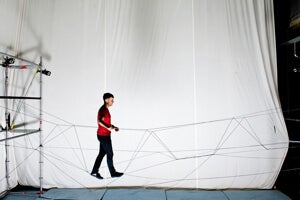Watch These Drones Build a Rope Bridge—and Intrepid Researchers Walk Over It

Share
Earlier this year, we wrote about a project to 3D print a bridge in Amsterdam. Said printer will move along a set of (self-printed) tracks, leaving a fully formed bridge in its wake. Now, machine bridge making is taking to the air—and swapping drones for 3D printers.
Dubbed the Aerial Construction project, ETH Zurich researchers equipped several quadcopters with spools of lightweight (but strong) rope, set up two scaffold anchors, measured and set their locations—and hit ‘go’. Using knots, links, and braiding the swooping drones looped the rope into a 7.4 meter bridge.
And then the researchers walked over it. (Happily, it held firm.)
The work adds to other experiments aimed at automating the building of large structures. A number of groups, for example, have been working to 3D print whole houses for years. Others are building bricklaying robots. And an old UPenn project used quadcopters to lift and place magnetically bound struts into a structure.
In this case, the researchers decided rope was a good building material because, at least for now, drones have a strict weight limit. Also, lifting and placing heavy, modular building materials requires greater precision. And of course, drones can work over empty space without supporting structures.
The dream scenario? Some intrepid scientist or National Geographic photographer is hacking through the jungle and encounters a deep chasm with no way to cross. Our explorer pops out a few handy bridge-drones, and away they go. (And undoubtedly there many other cool applications.)
Be Part of the Future
Sign up to receive top stories about groundbreaking technologies and visionary thinkers from SingularityHub.


The reality is a little different.
In this case, the drones use carefully placed, uniform steel scaffolding for anchors, not trees of unknown strength, growing at wild angles. Also, there’s the matter of positioning. The drones require a precise indoor tracking system so they can locate themselves in space and avoid crashing into their fellow flying workers.
And then there's the ever-present power problem. Drones have limited flight time due to battery limitations. The length and complexity of your bridge is tied to just how long the machines can stay airborne. And of course, if you're exploring the grey areas on the map, finding a charge will require sunshine at least.
But if the researchers can solve a few logistical problems, they can move outdoors. And with a few good anchors, hypothetically they could make jungle rope bridges.
Just not quite yet.
Image Credit: ETH Zurich
Jason is editorial director at SingularityHub. He researched and wrote about finance and economics before moving on to science and technology. He's curious about pretty much everything, but especially loves learning about and sharing big ideas and advances in artificial intelligence, computing, robotics, biotech, neuroscience, and space.
Related Articles

AI Companies Are Betting Billions on AI Scaling Laws. Will Their Wager Pay Off?

Super Precise 3D Printer Uses a Mosquito’s Needle-Like Mouth as a Nozzle

Is the AI Bubble About to Burst? What to Watch for as the Markets Wobble
What we’re reading

